Renovating a bathroom is exciting as you create a new vision for this room, making it practical and beautiful. I love choosing fittings, finishing, and accessories, even floor tiles. Let’s consider what the best tiles are for bathroom floors.
The best tiles for bathroom floors are waterproof, durable, easy to clean and maintain, beautiful, and cost-effective. According to these criteria, porcelain, ceramic, natural stone, and vinyl are the best tiles for bathroom floors.
While you can make aesthetics the central choice in other parts of the house, bathroom flooring must meet additional criteria first, or the floor will be ruined.
Bathrooms are hot, humid, and moist, so the floor needs to cope with this environment. What are the criteria you use when choosing bathroom floor tiles? And which are the best tiles to look at?

Relate Articles:
- 13 Ideas for Bathroom Accent Walls
- Tips for Choosing the Right Bathroom Rug Color
- 8 Best Colors for Bathroom Vanities
- 7 Best Paint Colors for Bathrooms Without Windows
Criteria for Choosing the Best Bathroom Floor Tiles
Before we introduce you to our go-to list of the best bathroom floor tiles, let’s check out the criteria for making a flooring decision.
What is the Ideal Material for Bathroom Tiles?
When deciding on the material for your tiles, there are a few questions you have to answer:
- Is the material waterproof? This will be a more significant consideration in bathrooms with tubs, showers, and wet rooms rather than powder rooms.
- Is it durable? Think about how much wear and tear your bathroom will face.
- Is it easy to clean and maintain? Keeping a clean and pristine bathroom is essential for family health and resale value.
The answer to these questions must be “yes” before considering other criteria.
What is the Perfect Tile Size?
Deciding on tile size is both a practical and aesthetic decision. My rule of thumb for tile size for bathroom floors is:
- Choose larger tiles if your bathroom is spacious, airy, and light.
- With fewer grout lines, larger tiles help to make smaller bathrooms look bigger, especially if you have a floating vanity.
- Smaller tiles work well in small bathrooms, maintaining proportion. I love retro penny tiles for vintage charm.
- Small tiles are also best for bathroom floors with irregular curves and angles. Mosaic tiles in a mixture of glass, ceramic, and marble create unique floors.
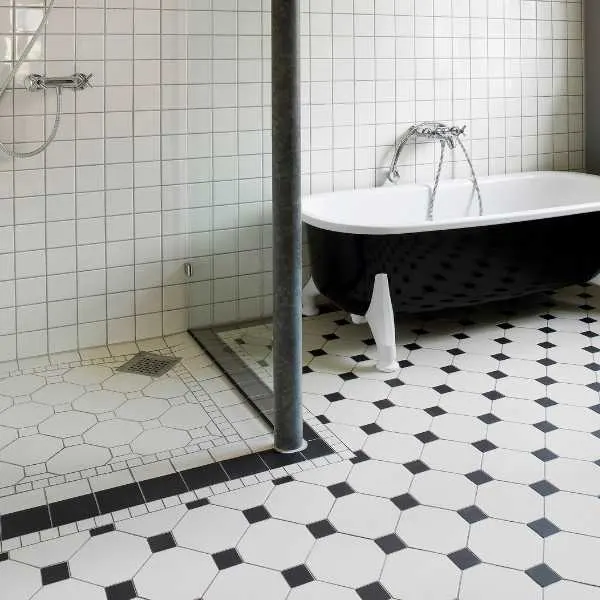
What Style, Color, Shape, And Finish is Best for Bathroom Floor Tiles?
Once you’ve decided on the material and size of the tile, you can start exploring the beautiful variety of colors and finishes available. These aesthetic considerations depend on the following:
- What architectural or interior design do you want the bathroom to have? The bathroom should carry through the house’s theme but can also be a little pocket of quirkiness.
- Do you need to focus on resale value? Buyers focus on bathrooms and look out for high-quality, beautiful tiles. They will also consider how easy specific colors and finishes are to keep clean. For instance, dark floor tiles won’t show dirt as easily, but they can create a claustrophobic feel.
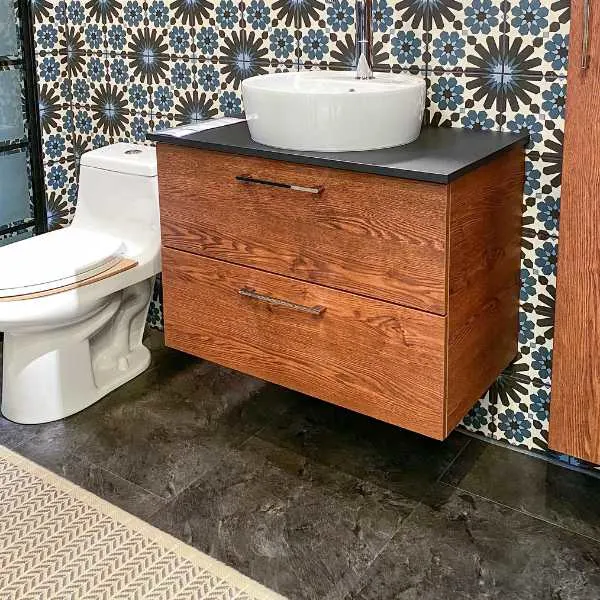
- Can you indulge personal taste? Your choice of colors and textures is essential, since a bathroom is a place to relax. My friend Susan created a white-tiled private spa but was stressed about the dirty marks the white tiles showed – so she wasn’t entirely satisfied.
What is the Budget for Bathroom Floor Tiles?
Deciding how much you can or want to spend on floor tiles will help you to make the right choice. There are practical and beautiful tiles available at every price. Also, consider the cost of installation and maintenance in your calculations.
4 Best Tiles for Bathroom Floors
Our research and experience show that these are the four most popular tiles for bathroom floors.
#1. Porcelain Tiles – Most Durable
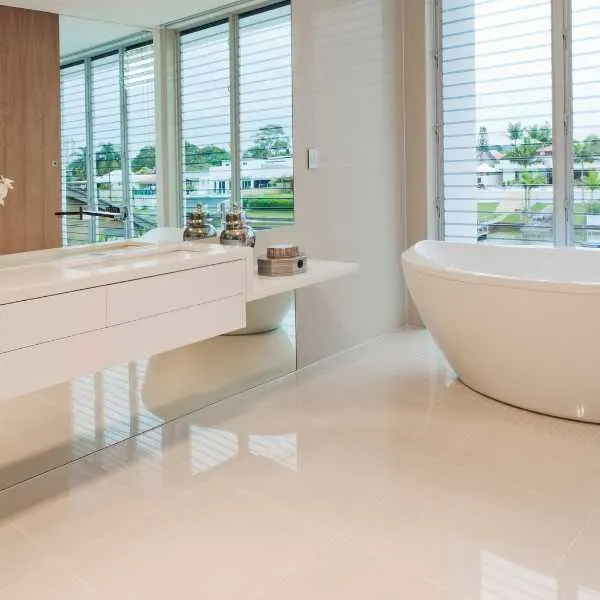
The most popular tiles for bathroom floors are porcelain because they are waterproof, durable, cost-effective, and available in any design.
Porcelain is a ceramic tile made of kaolin clay, quartz, and feldspar. The tiles are fired at around 2,500⁰F and receive a surface glaze consisting of liquified glass. This process results in a fine-grained, dense tile with a smooth surface.
The specialized material and production method mean porcelain tiles have a very low water absorption rate. In other words, porcelain tiles are waterproof, so they are not subject to water infiltration and dampness.
Porcelain tiles are also exceptionally durable and fire-resistant. They are harder and denser than other ceramics and unlikely to chip or scratch. If they chip, the tile is the same color throughout, making the chip less noticeable.
These tiles are easy to maintain, requiring mopping and wiping with water and floor soap. They are stain-resistant (hence ideal for families with kids).
No special maintenance is needed apart from periodically sealing the grout between the tiles against stains and mildew.
You can find porcelain tiles in any shape, size, color, and pattern to suit your interior design. Porcelain tiles can be manufactured to look like many other materials. Tiles that look like natural stone, wood, or terracotta without the issues of durability and water damage.
For example, if you long for an industrial-style bathroom, cement-look porcelain tiles are available. I love large, matte porcelain tiles in a natural marble finish for an adult’s bathroom. Still, I dream of a tiny powder room with black and white hexagonal tiles and Art Deco wallpaper.
If you find porcelain tiles cold and hard, consider installing under-floor heating and including some cozy non-slip mats. Mats are a fantastic way to introduce color into a bathroom.
Porcelain’s positive characteristics mean that porcelain tiles are not the cheapest choice, working out more expensive than other forms of ceramic tile. However, their hard-wearing durability is worth the outlay.
#2. Ceramic – Budget Friendly
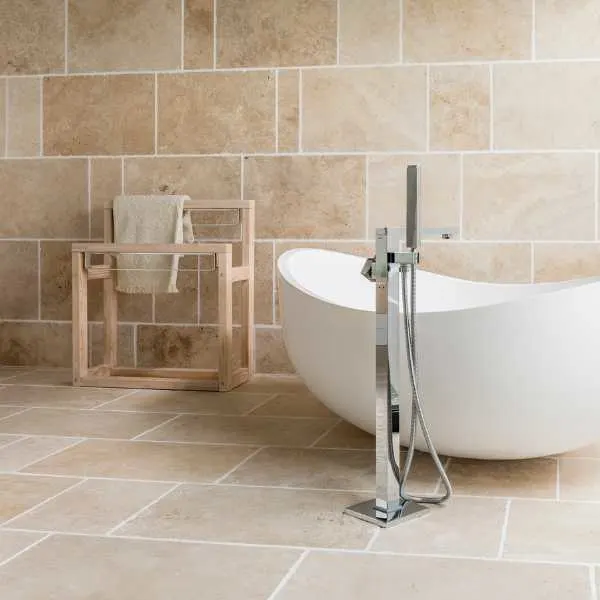
The second-most popular tile choice for bathroom flooring is ceramic tiles.
Ceramic tiles are produced from coarse red, white, or brown clay, fired in a kiln at 2,000⁰F, and the top surface is finished with a smooth protective and decorative glaze. Some ceramic tiles are left unglazed, such as terracotta.
Like porcelain tiles, ceramic tiles are dense and water-resistant. However, unglazed tiles and the sides and backs of glazed tiles are susceptible to water. Usually, grouting and cement protect the tiles’ unglazed parts, but cracks and chips can mean water infiltration.
Ceramic tiles are durable and fire-resistant but are prone to wear if traffic is heavy. As they are not as strong as porcelain tiles, ceramic tiles are more likely to crack, chip, and scratch. Chipping reveals the original clay under the glaze and can let in water.
Cleaning ceramic tiles is straightforward, with mopping all that is necessary. Most ceramic tiles are stain-proof, with only the grout and unglazed tiles needing periodic maintenance and sealing.
A wide range of colors, sizes, and finishes of ceramic tiles are available: polished, matte, glossy, and satin. You can find textured tiles that mimic wood grain or natural stone, as well as other patterns and designs.
Terracotta is an ancient form of ceramic tiles characterized by its red, earthy coloring and softer, warmer texture. These are a beautiful choice for a rustic bathroom, especially with an Italian or Moroccan theme.
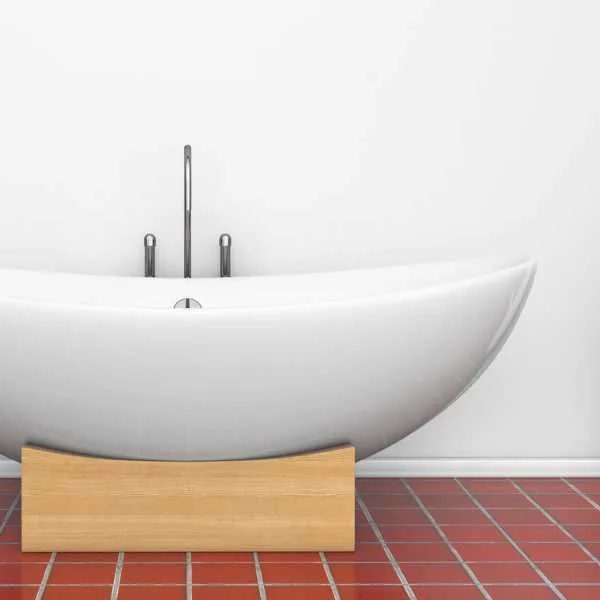
These tiles are generally not glazed, so terracotta tiles must be thoroughly sealed every two years if you want to use them in your bathroom. Unglazed and unsealed terracotta is not impervious to water and will sustain stains and damage.
We recommend ceramic tiles as a budget-friendly option: they’re cheaper than porcelain tiles and have many of the same qualities.
#3. Natural Stone Tiles – Best Luxury Tiles for Bathrooms
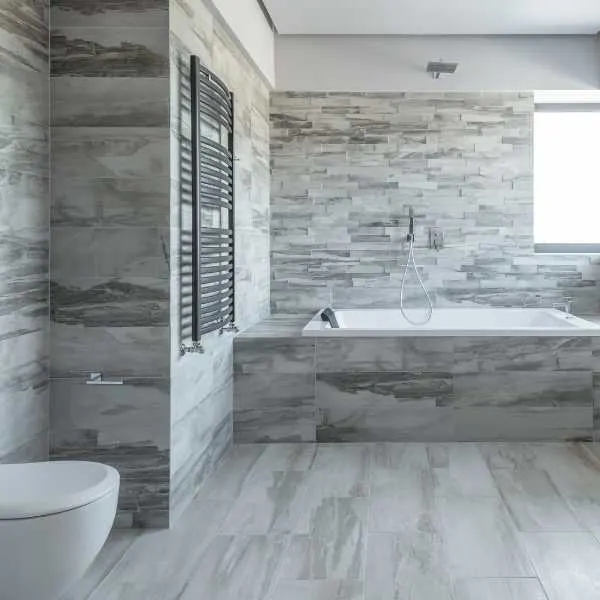
About 20% of bathrooms are built using natural stone tiles for flooring. The most popular stones are marble and limestone, although granite and slate are also used.
Natural stone was always the choice of the most wealthy, who could pay for the back-breaking labor and transport required. Today, marble and granite still maintain this royal mystique – I love bathrooms that showcase these tiles to their full glory.
Natural stone tiles are solid, durable, and hard-wearing. However, they are not nearly as waterproof or easy to maintain as porcelain and other ceramics.
All natural stone floor tiles must be carefully and correctly sealed, or they will be porous and subject to dampness, staining, and damage.
Also, consider the maintenance required for natural stone. Regular sealing is essential, and even cleaning is a challenge. Bleach and other strong chemicals damage the stone, making it brittle and flaky.
Still, with correct handling, natural stone tiles work well in luxury bathrooms and have a long life.
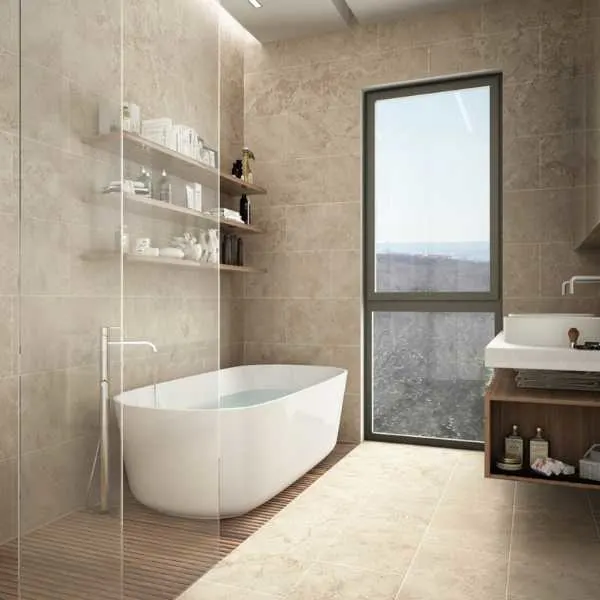
Natural stone is a perennially fashionable choice for bathroom flooring because it is gorgeous, and each tile is unique.
You can find stones ranging from the cream of limestone, the grey, blue, red, and green veins of marble to the charcoal greys of granite and slate. Textures and finishes include sandblasting, etching, and tumbling, all of which help avoid the slip factor.
Because natural stone is a high-quality finish, oozes style and exclusivity, and is magnificent to look at, your bathroom will have excellent resale value.
However, natural stone is the most expensive choice for bathroom flooring. You are not only paying for the stone itself, but for quarrying, cutting, polishing, and often importing it. Choosing a locally quarried stone is less expensive and more environmentally friendly.
Laying stone tile is also expensive as it is very heavy and breakable and requires treatment to avoid it being damaged and slippery.
If you’re like me – and not in the market for travertine marble – look at the exquisite natural stone alternatives made of porcelain.
#4. Vinyl Tiles – Most Affordable
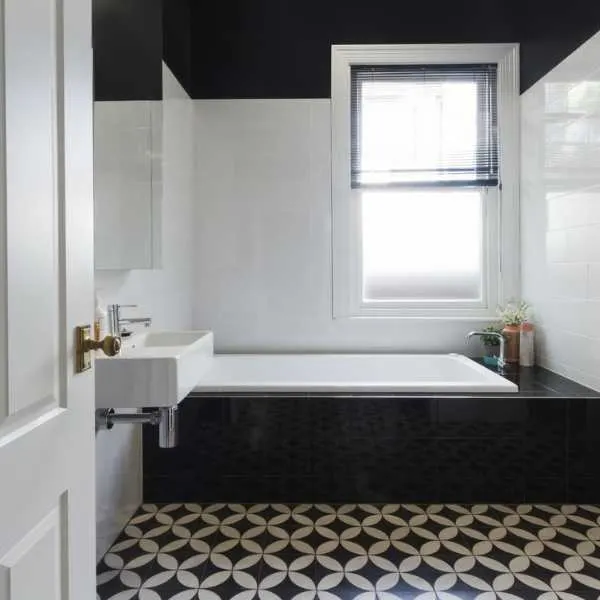
Vinyl tiles are another excellent choice for bathroom flooring.
If you’re thinking of vinyl as that old-fashioned material with felt backing, you’re in the wrong century. Modern vinyl is 100% synthetic, made of PVC, with UV-protective and scratch-resistant layers.
This popular flooring material is well-suited to bathrooms because it is durable and completely waterproof, mainly when laid down in a sheet without many seams where water could trickle. It can handle high-traffic areas and remains soft and comfortable underfoot.
Vinyl is also very low-maintenance, requiring mopping with a general floor cleaner. It can also withstand vigorous scrubbing to remove marks and stains.
You can choose from various vinyl patterns and finishes, including Luxury Vinyl Tiles (LVT), which mimic wooden planks. Don’t imagine those smeary finishes in your grandmother’s kitchen – you can find gorgeous designs.
Unfortunately, vinyl doesn’t add to the resale value of your bathroom. This is especially true if installed amateurishly, leaving bumps and gaps.
Apart from being extremely practical, vinyl is also cost-effective. It’s quick and easy to install, and modern vinyl is self-adhering.
Final Thoughts on the Best Floor Tiles for Bathrooms
Porcelain tiles are the ideal bathroom floor tiles, being durable, waterproof, cost-effective, and available in any design, shape, size, or color. Other ceramic tiles have similar characteristics and are cheaper. Nature stone is the best luxury tile for bathroom floors, but it is expensive. Vinyl is an excellent budget choice, being waterproof and durable, but it does not hold the same aesthetic appeal.

